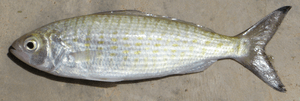Australian herring facts for kids
Quick facts for kids Australian herring |
|
|---|---|
 |
|
| Scientific classification | |
| Synonyms | |
|
Centropristes georgianus Valenciennes, 1831 |
The Australian herring (Arripis georgianus) is a cool fish found in the waters around southern Australia. It's also known by other names like ruff, tommy ruff, or Australian ruff. This fish is one of four types in the Arripis family.
Even though it's called a "herring," it's not actually related to the true herring family. It looks a bit like a smaller version of the Australian salmon. People in Australia have many names for it, including bull herring, sea herring, and tommy. The name "Ruff" is used worldwide for fishing.
Contents
What Does the Australian Herring Look Like?
The Australian herring has a sleek, slightly long body. It's a bit flat from side to side. Its head is quite small, but it has fairly large eyes. The mouth is medium-sized and opens upwards. Inside its mouth, it has small, pointy teeth.
Its body is covered in tiny scales, except for its lower jaw and snout. It has two main fins on its back (dorsal fins) and a small fin underneath (anal fin). Its tail fin is deeply split, like a fork. The fins on its sides (pectoral fins) are small.
This fish is shiny silver. It has black tips on its tail and cool gold spots along its upper body. Young Australian herring have dark golden stripes on their sides. The biggest Australian herring found was about 41 centimeters (16 inches) long. But usually, they are about 25 to 30 centimeters (10 to 12 inches) long.
Where Do Australian Herring Live?
The Australian herring lives only in the cooler waters of southern Australia. You can find them from the Swan River in Western Australia all the way along the south coast. They also live up the east coast to Forster, New South Wales. You can find them around Tasmania too.
How Do They Live and Grow?
Australian herring love to hang out in big groups called schools. You can find them in places like sea-grass beds, near beaches, over reefs, and in coastal bays. They usually swim close to the surface of the water.
These fish are predators, which means they hunt for their food. They eat smaller fish and tiny creatures that live in the seaweed and sea-grass.
Australian herring become adults and can have babies when they are about 2 or 3 years old. When it's time to lay eggs, they travel west along the Australian coast. They meet up with other adult herring in the southwest to spawn (lay eggs). This usually happens from April to June.
A female herring can lay a lot of eggs! A 20-centimeter (8-inch) fish might lay 50,000 eggs. A bigger 33-centimeter (13-inch) female can lay up to 200,000 eggs in one season.
The eggs, tiny baby fish (larvae), and young fish are all very small. They float in the ocean currents, like the Leeuwin Current. These currents carry them south along the west coast and east along the south coast. When the young fish are about 3 to 6 centimeters (1 to 2 inches) long, they settle down. They find special nursery areas along the south coast to grow.
After the adult fish have spawned, they stay off the west coast of Western Australia. They don't go back to the south coast. They spread out along the coast, sometimes even going into estuaries and as far north as Shark Bay.
Fishing for Australian Herring
In most parts of Australia, the Australian herring is a popular fish for people who fish for fun. But in Western Australia, it's also important for commercial fishing. This means people catch them to sell.
Fishermen use different methods to catch them, like lines, gill nets, and seine nets. They used to use special 'G' trap nets, but this was stopped in 2015 to help protect the fish population.
Australian herring have soft, slightly oily meat. Many people think they are a very tasty fish to eat!
How the Australian Herring Got Its Name
The Australian herring was first officially described in 1831. A scientist named Achille Valenciennes gave it the name Centropristes georgianus. He found it near King George Sound in Western Australia. Later, another scientist, Leonard Jenyns, put it into a new group of fish called Arripis. The Australian herring was the first fish to be placed in this new group.
- Froese, Rainer and Pauly, Daniel, eds. (2005). "Arripis georgianus" in FishBase. November 2005 version.

